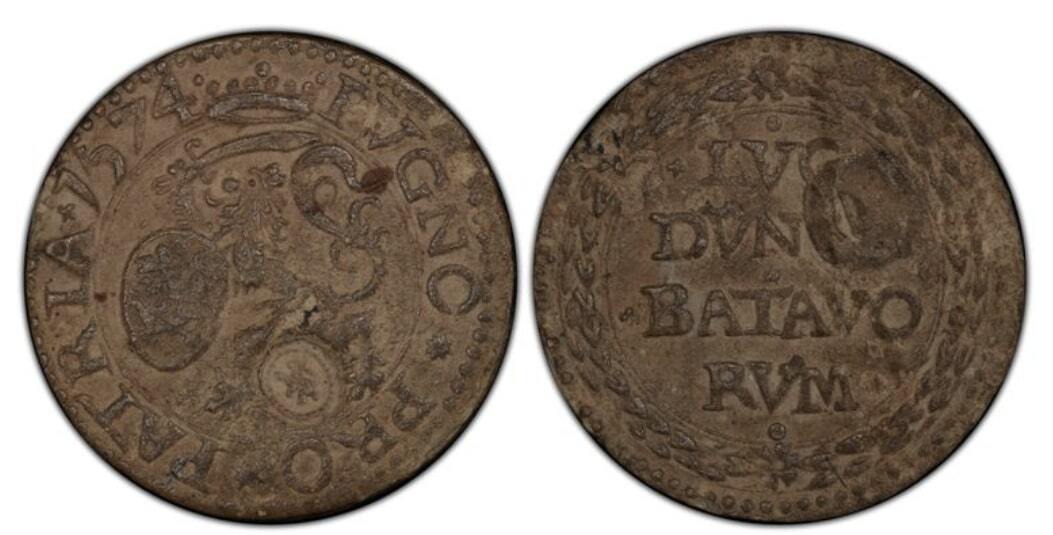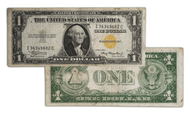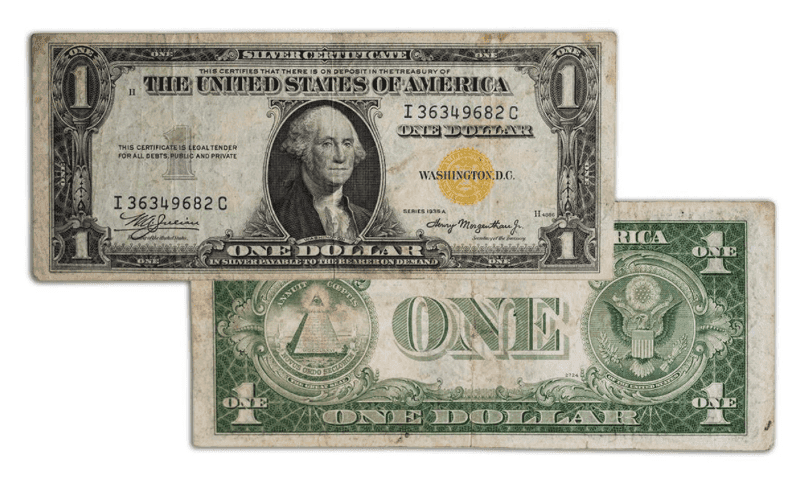Siege Money and Necessity Notes: Emergency Coinage That Saved Cities
Posted by Andrew Adamo - A certified ANA Professional Numismatist, Active member of ICTA, contributor to CoinWeek, Numismatic News, NGC and ANA on Jul 8th 2025
Siege Money and Necessity Notes: Emergency Coinage That Saved Cities
When the gates of Leiden shut in 1573, its citizens were trapped—surrounded by Spanish forces, cut off from supply lines, and rapidly running out of everything, including money. But necessity breeds invention. The Dutch turned cardboard from prayer books into square-shaped coins. Crude, fragile, and desperately needed, this emergency money helped the city survive months of famine and siege. And Leiden wasn’t alone.
Across history, communities facing military sieges, political instability, or economic collapse turned to improvisation. Siege money and necessity notes stand as physical reminders of how commerce persisted in the darkest hours. While they began as tools of survival, these improvised currencies have become some of the most sought-after collectibles in the numismatic world.
*1935A WWII North Africa $1 Emergency Note
What Is Siege Money?
Siege money refers to coins and tokens issued during wartime sieges, typically when a city or stronghold is cut off from its standard currency sources. These emergency coins were produced locally, often in hastily built “mints” using whatever materials were available—silverware, church relics, pewter dishes, cardboard, leather, or even lead.
Their design was typically minimal: simple shapes (often rectangular or square), stamped with only the date, denomination, and sometimes the name or symbol of the besieged city.
Key Characteristics:
-
Crude design: Functional rather than artistic
-
Limited mintage: Produced in very small quantities
-
Unique materials: Often melted domestic silver or improvised media
-
Context-rich: Closely tied to specific events in history
Famous Examples of Siege Money
Leiden, Netherlands (1573–1574)
As part of the Eighty Years’ War, the Dutch city of Leiden was besieged by Spanish forces. Cut off from normal supplies, the city issued emergency currency made from cardboard and parchment. These pieces were often stamped with civic seals and used to pay soldiers and keep trade alive within the city walls.
1574 1/4 Gul VG-52b Leiden - XF45

Newark, England (1645–1646)
During the English Civil War, Royalist forces in Newark issued emergency coinage in lead and silver while under siege by Parliamentarian troops. The coins, primarily shillings and half-crowns, often featured a simple crown design and the inscription “OBS” for “obsidebat” (Latin for “besieged”).
These coins are especially valuable today due to their historical connection to King Charles I’s struggle and the craftsmanship involved in their emergency production.
1646 6D S-3146 Newark MS62

Vienna, Austria (1683)
The Second Siege of Vienna by Ottoman forces saw a variety of emergency measures, including the issuance of siege money made from melted church valuables. When relief came—thanks to the combined forces of the Holy Roman Empire and the Polish–Lithuanian Commonwealth—these coins became commemorative relics of a turning point in European history.
Mafeking, South Africa (1900)
During the Boer War, the British-controlled town of Mafeking was besieged for 217 days. Colonel Robert Baden-Powell (later founder of the Boy Scouts) authorized the issuance of postage-stamp currency and cardboard siege notes to pay troops and facilitate trade. Today, these pieces are prized by both numismatists and philatelists.
Necessity Notes: Emergency Currency Without a Siege
Not all emergency currency emerged from warfare. Economic collapse, inflation, and disruption of centralized authority also gave rise to localized, unofficial currency.
The most famous example is the Notgeld (German for "emergency money") issued in Germany and Austria between 1914 and the early 1920s.
Notgeld in Germany and Austria
In the wake of World War I, the German economy spiraled into chaos. As the Weimar Republic struggled to regain control, towns, businesses, and even private individuals issued emergency currency.
Key characteristics of Notgeld:
-
Printed in huge variety of styles
-
Issued in denominations from 1 pfennig to trillions of marks (in the inflationary period)
-
Made from paper, silk, leather, linen, aluminum, porcelain, and even coal dust
-
Often illustrated with regional landmarks, satire, or patriotic imagery
Some Notgeld series were produced not for circulation, but to sell to collectors as souvenirs. As a result, collectors today can find entire thematic sets—such as fairy tale series, historic battle commemorations, or regional folklore—from cities like Hamburg, Leipzig, or Meissen.
Other Examples of Necessity Currency
Spain (1936–1939): Civil War Local Issues
During the Spanish Civil War, both Nationalist and Republican zones issued localized currency, sometimes backed by cooperatives or town councils. These were typically crude, short-lived, and politically charged, reflecting the splintering of authority during conflict.
WWII Internment Camps and POW Camps
In both Allied and Axis nations, token currency was issued to prisoners of war and internees. This included camps in the U.S., Germany, and the UK. These "camp money" issues allowed prisoners to make controlled purchases and were often marked "valid only in camp" to prevent circulation outside the wire.
Post-War Yugoslavia and Zimbabwe
Hyperinflation struck Yugoslavia in the early 1990s and Zimbabwe in the 2000s. In both instances, national governments issued currency in absurd denominations—up to 500 billion dinars in Yugoslavia and 100 trillion dollars in Zimbabwe. These are not strictly “necessity notes” in the historical sense, but they represent modern examples of emergency monetary measures.
Historical Context and Monetary Data
According to the Journal of Monetary History, the use of siege money peaked between the 16th and 18th centuries, primarily in Europe. Over 100 documented sieges in Europe alone during this period resulted in emergency coin issuance.
A study by numismatist W.H. Valentine estimates that fewer than 1,000 genuine examples of siege coins survive from some cities (like Newark), with many pieces in institutional collections and museums.
Meanwhile, the German Notgeld Collectors Society estimates that over 15,000 different designs of Notgeld were issued between 1914 and 1924, with many still uncatalogued.
How Bullion Shark Helps You Collect the Unexpected
At Bullion Shark, our mission extends beyond metal value. We specialize in curating pieces that connect collectors with stories—real ones, of survival and innovation.
Our auction platform regularly features:
-
Newark and Vienna siege coinage
-
Notgeld series in excellent condition
-
Rare internment camp tokens
-
Spanish Civil War local issues
We also provide historical authentication, grading assistance, and expert advisory to help collectors navigate this fascinating, underappreciated area of numismatics.
A Collector's Approach: Building a Narrative
Unlike traditional collecting goals based solely on metal content or mintmarks, emergency currency invites you to build a collection based on themes:
-
"Cities Under Siege" Collection: Featuring coinage from Vienna, Maastricht, or Antwerp
-
"Crisis and Collapse" Series: Notes from Weimar Germany, Zimbabwe, and Argentina
-
"Wartime Innovation" Set: Camp money, ration tokens, and emergency stamp money
Each of these tells a broader human story of how people responded to crisis through ingenuity and adaptation.
Tips for Collectors
-
Research First: Start with reference guides such as "Siege Coins of the World" by Elvira Clain-Stefanelli or the Notgeld catalog by Hans-Ludwig Grabowski.
-
Beware of Fakes: Especially for rare siege coins—Leiden, Vienna, and Newark pieces are heavily counterfeited.
-
Start Small: Notgeld is one of the most affordable entry points into the field, with many pieces available for under $20.
-
Consider Grading: While many siege and emergency coins are in rough shape, certified examples command premium prices.
-
Use Trusted Dealers: Work with specialists like Bullion Shark to ensure authenticity and fair pricing.
The Legacy of Emergency Money
From the cardboard coins of Leiden to the beautifully illustrated Notgeld of post-WWI Germany, emergency currency reflects human resilience. They were created not for profit, but for purpose. They show what happens when established systems collapse—and how people find ways to carry on.
As the world continues to experience uncertainty—wars, inflation, supply chain disruptions—emergency money from the past feels increasingly relevant. It’s a reminder that currency is not just a medium of exchange, but a reflection of the society that produces it.
For collectors who want more than just silver weight—for those who value history, innovation, and narrative—siege and necessity money offers a rich, underexplored frontier.
At Bullion Shark, we believe in the power of coins to teach and inspire. Emergency money tells us more than how people traded—it shows us how they endured. It offers collectors the chance to hold a piece of humanity's response to crisis, innovation in the face of collapse.
Whether you're starting with a single Notgeld note or ready to bid on a Newark shilling, your journey begins with the story. And we're here to help you find it.
Explore our latest inventory of historic banknotes >



